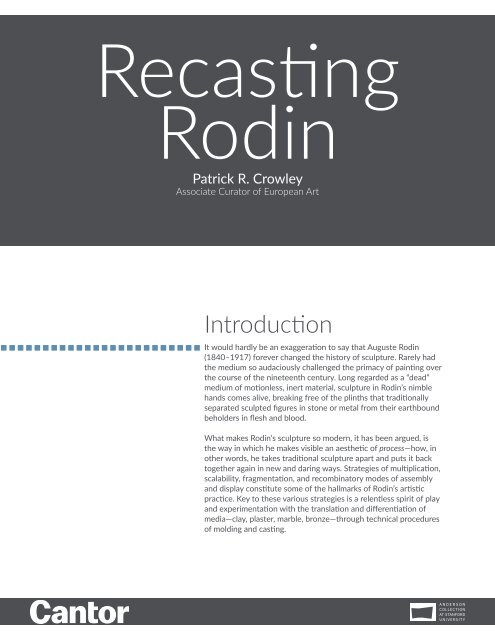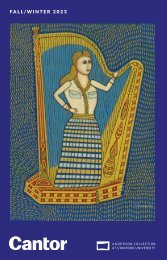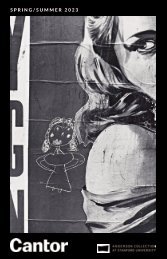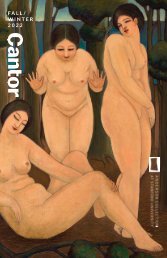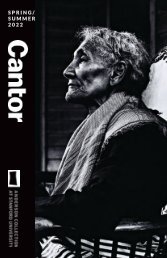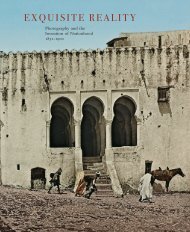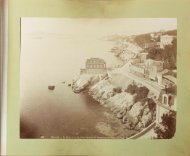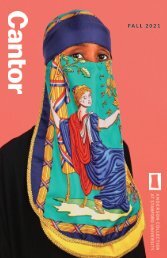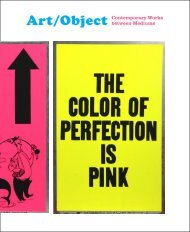Learning Guide | Recasting Rodin
It would hardly be an exaggeration to say that Auguste Rodin (1840–1917) forever changed the history of sculpture. Rarely had the medium so audaciously challenged the primacy of painting over the course of the nineteenth century. Long regarded as a “dead” medium of motionless, inert material, sculpture in Rodin’s nimble hands comes alive, breaking free of the plinths that traditionally separated sculpted figures in stone or metal from their earthbound beholders in flesh and blood. Patrick R. Crowley, PhD Associate Curator, European Art Cantor Arts Center
It would hardly be an exaggeration to say that Auguste Rodin (1840–1917) forever changed the history of sculpture. Rarely had the medium so audaciously challenged the primacy of painting over the course of the nineteenth century. Long regarded as a “dead” medium of motionless, inert material, sculpture in Rodin’s nimble hands comes alive, breaking free of the plinths that traditionally separated sculpted figures in stone or metal from their earthbound beholders in flesh and blood.
Patrick R. Crowley, PhD
Associate Curator, European Art
Cantor Arts Center
You also want an ePaper? Increase the reach of your titles
YUMPU automatically turns print PDFs into web optimized ePapers that Google loves.
<strong>Recasting</strong><br />
<strong>Rodin</strong><br />
Patrick R. Crowley<br />
Associate Curator of European Art<br />
■ ■ ■ ■ ■ ■ ■ ■ ■ ■ ■ ■ ■ ■ ■ ■ ■ ■ ■ ■ ■ ■ ■ ■<br />
Introduction<br />
It would hardly be an exaggeration to say that Auguste <strong>Rodin</strong><br />
(1840–1917) forever changed the history of sculpture. Rarely had<br />
the medium so audaciously challenged the primacy of painting over<br />
the course of the nineteenth century. Long regarded as a “dead”<br />
medium of motionless, inert material, sculpture in <strong>Rodin</strong>’s nimble<br />
hands comes alive, breaking free of the plinths that traditionally<br />
separated sculpted figures in stone or metal from their earthbound<br />
beholders in flesh and blood.<br />
What makes <strong>Rodin</strong>’s sculpture so modern, it has been argued, is<br />
the way in which he makes visible an aesthetic of process—how, in<br />
other words, he takes traditional sculpture apart and puts it back<br />
together again in new and daring ways. Strategies of multiplication,<br />
scalability, fragmentation, and recombinatory modes of assembly<br />
and display constitute some of the hallmarks of <strong>Rodin</strong>’s artistic<br />
practice. Key to these various strategies is a relentless spirit of play<br />
and experimentation with the translation and differentiation of<br />
media—clay, plaster, marble, bronze—through technical procedures<br />
of molding and casting.
■ ■ ■Object Narratives<br />
1<br />
Perhaps the best, and no doubt the most complex, example of <strong>Rodin</strong>’s modernity<br />
is The Gates of Hell. Like the museum of decorative arts in Paris for which it was<br />
commissioned, the Gates of Hell was never fully realized: at the time of <strong>Rodin</strong>’s<br />
death, it remained a plaster model in the studio, assembled only posthumously<br />
in bronze as a complete ensemble. The state of unfinish was not for lack of<br />
dedication. Indeed, <strong>Rodin</strong> continuously labored over the work for nearly four<br />
decades—adding, subtracting, and modifying figures in an ever-changing<br />
narrative and spatial frame that was loosely based on the tumbling, weightless<br />
souls in Dante’s Inferno. The fruits of this labor can be seen in several of the most<br />
iconic works in <strong>Rodin</strong>’s oeuvre on display at the Cantor scaled up and down in<br />
various permutations, among them The Three Shades and The Thinker. For the art<br />
historian Leo Steinberg, The Gates of Hell constituted not just a masterpiece, but<br />
indeed a kind of referential storehouse, a “dumping ground and Noah’s Ark” of<br />
<strong>Rodin</strong>’s very best years of work.<br />
Since antiquity, artists have employed techniques of molding and casting in<br />
order to replicate existing natural objects or works of art (e.g., plaster copies of<br />
marble statues) or fashion new ones that are intrinsically replicable (as in the case<br />
of bronze casting). In the case of the lost-wax method used by <strong>Rodin</strong>, a hollow<br />
mold, produced through the direct physical contingency of liquid substances<br />
and solid forms, guarantees an extraordinary degree of resemblance between<br />
the original and the resultant cast in bronze (see the video for a detailed, stepby-step<br />
look at the process of lost-wax casting of The Gates of Hell). For <strong>Rodin</strong>,<br />
that “original” was typically a clay model. Subsequently, his assistants would<br />
transform these clay models into the marbles counterparts with which we are<br />
familiar today, or, in the case of bronzes, deliver the artist’s finished work to the<br />
foundries where <strong>Rodin</strong> himself reportedly never set foot.<br />
2<br />
Traditionally viewed as a “mechanical,” hence slavish and indeed mindless mode<br />
of copying or reproduction—one entrusted to skilled, but typically anonymous<br />
technicians—these procedures of molding and casting rarely occasion deeper<br />
analysis. As a kind of material stenography, the technical apparatus of molding<br />
and casting is useful not only because of its capacity for multiplication, but also<br />
in its omission of style on the part of anyone but the artist in the operative chain.<br />
At the same time, these techniques compel us to think carefully about what we<br />
think we mean by the status of an “original.”<br />
<strong>Rodin</strong> offers an intriguing case for considering issues of authorship and the status<br />
of what constitutes an “original.” If by “original,” we mean a sculpture that bears<br />
the direct traces of the artist’s finishing touches in chiseled marble or chased<br />
bronze, then virtually none of the works we know by <strong>Rodin</strong> could be considered<br />
as such. Yet originality can be defined in other ways. Upon his death, the control<br />
of <strong>Rodin</strong>’s estate was given over to French government, and the Musée <strong>Rodin</strong> in<br />
Paris serves to this day as the arbiter of what counts as a legal “original” by <strong>Rodin</strong>.<br />
Indeed, the vast majority of the Cantor’s collection of <strong>Rodin</strong> comprises such<br />
posthumous, authorized “originals.” As such, they raise provocative questions<br />
about the status of these kinds of works. For some, these questions of originality<br />
3<br />
1. Auguste <strong>Rodin</strong>, France, 1840–1917. The Gates of Hell (La Porte de l’Enfer) 1880-c.1900. Bronze. 250-3/4 x 158 x 33-3/8 in. 636.9 x<br />
401.3 x 84.8 cm. Credit line: Gift of the B. Gerald Cantor Collection. Accession no.: 1985.86<br />
2. Auguste <strong>Rodin</strong>, France, 1840–1917. The Three Shades (Les ombres) 1881-1886. Bronze. 38-1/2 x 35-1/2 x 17-3/4 in. 97.8 x 90.2 x<br />
45.1 cm. Credit line: Gift of the Iris and B. Gerald Cantor Collection. Accession no.: 1998.360<br />
3. Auguste <strong>Rodin</strong>, France, 1840–1917. The Thinker, large version (Le Penseur, grand modèle) 1902-1904, first modeled 1880-1881.<br />
Bronze. 71-1/2 x 31 x 56 in. 181.6 x 78.7 x 142.2 cm. Credit line: Iris and B. Gerald Cantor Foundation, promised gift to the Iris & B.<br />
Gerald Cantor Center for Visual Arts at Stanford University. Accession no.: 1988.106<br />
2
are simply anachronistic and had no currency for <strong>Rodin</strong>, whose approach to his own<br />
process was so elastic. For others, the conceit of an “authentic copy” is merely a myth or<br />
necessary fiction to assert and preserve a romantic notion of a singular artistic vision and<br />
authorship.<br />
<strong>Rodin</strong>’s The Age of Bronze, represented in multiple versions at the Cantor, offers a<br />
compelling example of the fraught relationship between casting, authorship, and the<br />
status of an imputed “original.” First exhibited as a full-scale plaster figure in 1877,<br />
indeed the first that <strong>Rodin</strong> showed under his own name, The Age of Bronze was quickly<br />
mired in controversy when a critic accused him of having cast it from life—an accusation<br />
that infuriated <strong>Rodin</strong> as it slanderously reduced his expressive virtuosity to a merely<br />
mechanical operation. The figure was later cast in bronze and exhibited for the first time<br />
in 1880. In addition to the full-scale bronze (71 x 20 x 20 in.), we might compare two<br />
subsequent reductions: a first one in bronze (39 x 15.5 x 13 in.) and a second in plaster<br />
that has been patinated to look like bronze (26 x 8.5 x 17.78 in.). <strong>Rodin</strong> himself was<br />
4 5 6<br />
deeply invested in the scalability and scalar effects of his work: one of his technicians,<br />
Henri Lebossé, advertised his ability to produce enlargements and reductions of various<br />
objects using a “mathematically perfected process” using a “special machine” that could<br />
create “counterparts” in serial “editions.”<br />
The potential for risk here is that unauthorized editions (and thus not technically true<br />
“reproductions” according to some definitions) could potentially include not only casts<br />
made after the original plaster, but also casts of casts (surmoulage). What such a process<br />
gains in terms of ease in creating multiples from an extended replica series, it loses in<br />
terms of the potential for a real, physical distortion from the original: not only does the<br />
definition of surface details gradually dissolve with each subsequent reduction, but also<br />
the size of the cast of the cast shrinks as the bronze cools. Hence, as a form of both<br />
4. Auguste <strong>Rodin</strong>, France, 1840–1917. The Age of Bronze (L’âge d’airain), 1875-1876. Bronze. 71 x 20 x 20 in. 180.3 x 50.8 x 50.8 cm. Credit line: Gift of the B. Gerald Cantor Collection. Accession no.:<br />
1983.300<br />
5. Auguste <strong>Rodin</strong>, France, 1840–1917. The Age of Bronze, first reduction (L’Âge d’airain, première réduction). 1903-1904, first modeled 1875-1876. Bronze. 39 x 15-1/2 x 13 in. 99.1 x 39.4 x 33 cm. Credit<br />
line: Gift of the Iris and B. Gerald Cantor Foundation. Accession no.: 1974.51<br />
6. Auguste <strong>Rodin</strong>, France, 1840–1917. The Age of Bronze, second reduction (L’Âge d’airain, deuxième réduction). 1907, first modeled 1875-1876. Plaster. 26 x 8-1/2 x 7 in. 66 x 21.6 x 17.8 cm. Credit line:<br />
Gift of the Iris and B. Gerald Cantor Foundation. Accession no.: 1984.431<br />
3
7<br />
authorial and quality control, there is a legal limit<br />
(twelve in the case of <strong>Rodin</strong>, as determined by French<br />
law) to the number of bronzes that can be produced<br />
in an “original edition.” In order to differentiate them<br />
from unauthorized “fakes,” each one is numbered<br />
and marked with the foundry name. Yet even beyond<br />
these foundry marks, other distinctions still obtain:<br />
connoisseurs, for example, often prize the subtle<br />
differences in the patination of the bronzes, with<br />
those produced during <strong>Rodin</strong>’s lifetime evincing an<br />
especially extraordinary range of coloristic effects.<br />
Even beyond the highly technical complexities of<br />
bronze casting, <strong>Rodin</strong>’s fondness for plaster casts,<br />
notwithstanding the fragility of the medium and its<br />
tendency to accrue a grimy patina of dust and dirt,<br />
signals a recursive relationship to issues of authorship<br />
and media. Take, for example, his portrait of<br />
Madame Fenaille, the wife of one of his most ardent<br />
supporters. Originally executed in marble by <strong>Rodin</strong>’s<br />
assistant (practicien), the bust was subsequently<br />
transformed into a plaster that could then be used as<br />
a record of the marble for posterity or else produced<br />
for sale. Here we see how the plaster indexes the<br />
marble through the marks of the chisel in the hair<br />
and at the base. These marks reverently evoke<br />
Michelangelo’s famous nonfinito works that so enchanted <strong>Rodin</strong> on his travels in Italy: sculptures that stage their<br />
various states of unfinish as a deliberate aesthetic—one that points to the Neoplatonic aim of the Renaissance master<br />
to liberate his figures from their marmoreal prisons. Yet what<br />
the dull plaster faithfully records through its form-hugging,<br />
viscous materiality, it loses in terms of the luminous quality of<br />
8<br />
marble whose crystalline structure gleams and glitters in the<br />
light. In so doing, <strong>Rodin</strong> draws attention to the differentiation<br />
of media that constitutes an enduring theme of his work.<br />
The magic of plaster, as <strong>Rodin</strong> shrewdly recognized, lay in its<br />
material capacity for manipulation—a manipulation not only<br />
of form, but also of space. Nowhere is this more evident than<br />
<strong>Rodin</strong>’s prodigious output of plaster hands. Many of these—at<br />
least 150 examples—were stored in chests of drawers and<br />
pulled out for visitors as if they were anatomical specimens<br />
or religious ex-votos, with one such visitor remarking that<br />
<strong>Rodin</strong> would “pick them up tenderly one by one and then<br />
turn them about and lay them back.” Thanks to their lightness,<br />
<strong>Rodin</strong> could deploy these disembodied hands in space in<br />
inventive ways in order to work out compositional problems<br />
in his larger sculptural ensembles. A photograph by E. Freuler<br />
(Suspended Hand in Plaster) shows a plaster study of the<br />
left hand of Eustache de Saint-Pierre, one of the figures in<br />
his monumental work, The Burghers of Calais. Strung up on<br />
a rig so that it hangs pendulously, at once defying gravity<br />
7. Auguste <strong>Rodin</strong>, France, 1840–1917. Madame Fenaille c. 1900. Plaster. 25-3/4 x 24-3/4 x 21 in. 65.4<br />
x 62.9 x 53.3 cm. Credit line: Gift of the B. Gerald Cantor Collection. Accession no.: 1983.205<br />
8. E. Freuler, France, late 19th century- early 20th century. Suspended Hand in Plaster 20th century.<br />
Salt print. 11.3 x 8.4 cm. (sheet/image). Credit line: Gift of Albert E. and Patricia Elsen. Accession no.:<br />
1986.434<br />
4
9 10<br />
and making it visible, the suspended hand<br />
testifies to how <strong>Rodin</strong> thinks in space—space<br />
that is alternately positive and negative like the<br />
negative molds and positive casts that comprise<br />
his working process.<br />
In contrast to the seeming weightlessness<br />
of the plaster hand in the photograph, a<br />
weightlessness that recalls the writhing figures<br />
strewn across The Gates of Hell, there is an<br />
emphatic heaviness in the bronze casts of<br />
these hands. A bronze cast of the very same<br />
vascular left hand of Eustache de Saint-Pierre<br />
offers a powerful demonstration of the material<br />
consequences of this medial translation of<br />
plaster into bronze. Contrary to <strong>Rodin</strong>’s usual<br />
practice, the mounting of these hands for<br />
museum display typically reorients them in ways<br />
that transform the gestural liveliness of these<br />
detached appendages into intensely ponderous<br />
objects: heavy, serious, immobile.<br />
A bronze cast of <strong>Rodin</strong>’s Hand Holding a Torso<br />
offers an intriguing exception that ties together these interwoven themes of process, media, and authorship. Just three<br />
weeks before his death in 1917, <strong>Rodin</strong> consented to have his own hand cast in plaster by his assistant, Paul Cruet, who<br />
combined it with a female torso by his master. The addition of the torso enlivens the hand that handles it, orienting it<br />
in space. At the same time, the juxtaposition of the hand and the torso points up the differences between them: the<br />
indexical traces of <strong>Rodin</strong>’s flesh (even more visible in the plaster counterparts) versus the expressiveness of the silky<br />
female nude. It is ironic that <strong>Rodin</strong> should have reconsidered his longtime aversion to life casting mere weeks before his<br />
death. For even as the hand of the living artist inevitably projects an aura of creative spirit, it also evokes a mortiferous<br />
quality as a kind of fossilized, fetishistic part-object—one that was memorialized by Honoré de Balzac in his Le chef<br />
d’oeuvre inconnu (1831-1837):<br />
Well, try to make a cast of your<br />
mistress’s hand, and set up the thing<br />
before you. You will see a monstrosity,<br />
a dead mass, bearing no resemblance<br />
to the living hand; you would be<br />
compelled to have recourse to the<br />
chisel of a sculptor who, without<br />
making an exact copy, would represent<br />
for you its movement and its life.<br />
11<br />
In <strong>Rodin</strong>’s Hand Holding a Torso, then, we see<br />
not only an uncanny foreshadowing of the<br />
artist’s death, but also, as Balzac recognized, a<br />
kind of deathliness in the uneasy synthesis of<br />
life casting and expressive form.<br />
10. Auguste <strong>Rodin</strong>, France, 1840–1917. Eustache de Saint-Pierre, left hand, final state (Eustache de Saint-Pierre, main gauche, état definitif). c. 1886. Bronze. 11 x 5-1/2 x 5-3/4 in. 27.9 x 14 x 14.6 cm.<br />
Credit line: Gift of the Iris and B. Gerald Cantor Collection. Accession no.: 1998.359<br />
11. Auguste <strong>Rodin</strong>, France, 1840–1917. <strong>Rodin</strong>’s Hand Holding a Torso (La main de <strong>Rodin</strong> tenant un torse) 1917. Bronze. 7 x 9 x 15-1/2 in. 17.8 x 22.9 x 39.4 cm. Credit line: Gift of the Iris and B. Gerald<br />
Cantor Foundation. Accession no.: 1974.48<br />
5
■ ■ ■Questions<br />
1. What kinds of value do we attribute to an original versus a copy? To what extent do you think it’s possible<br />
to learn about the intentions of the artist through objects that were never physically touched by the<br />
artist’s hand?<br />
2. What do you make of the role of the assistant or technician (or the fabricator, as they are often called<br />
today) in bringing the artist’s vision to life?<br />
3. Given that <strong>Rodin</strong> was so hostile to the practice of life casting, what do you think it is about his treatment<br />
of the body that compels us to rethink the relationship between art and nature?<br />
■ ■ ■Selected Bibliography<br />
Adamson, Glenn and Joshua G. Stein. “Imprints: Scale and the Maker’s Trace,” in<br />
Scale, ed. Jennifer L. Roberts (Chicago: Terra Foundation for American Art, 2018), 28-63.<br />
Didi-Huberman, Georges. L’Empreinte (Paris: Centre Georges Pompidou, 1997).<br />
Elsen, Albert E. <strong>Rodin</strong>’s Art: The <strong>Rodin</strong> Collection of the Iris & B. Gerald Cantor<br />
Center for Visual Arts at Stanford University (with Rosalyn Frankel Johnson, ed. Bernard Barryte) (Oxford:<br />
Oxford University Press, 2003).<br />
-----------, “<strong>Rodin</strong>’s ‘Perfect Collaborator,’ Henri Lebossé,” in Albert E. Elsen, ed.,<br />
<strong>Rodin</strong> Rediscovered (Washington, DC: The National Gallery of Art, 1981), 249-259.<br />
Hass, Nancy. “Are Fabricators the Most Important People in the Art World?” NYT<br />
June 22, 2018: https://www.nytimes.com/2018/06/22/t-magazine/art-fabricators.html<br />
Janson, H.W. “Realism in Sculpture: Limits and Limitations,” in The European<br />
Realist Tradition, ed. Gabriel P. Weisberg (Bloomington, IN: Indiana University Press, 1982), 290-301.<br />
Krauss, Rosalind E. “Sculpture in the Expanded Field,” October 8 (1979), 30-44.<br />
-----------, “Sincerely Yours: A Reply,” October 20 (1982), 110-130.<br />
Pointon, Marcia. “Casts, Imprints, and the Deathliness of Things: Artifacts on the<br />
Edge,” Art Bulletin 96 (2014), 170-195.<br />
Steinberg, Leo. “<strong>Rodin</strong>,” in Other Criteria (New York: Oxford University Press,<br />
1972), 322-403.<br />
■ ■ ■Contact Information<br />
Patrick R. Crowley, Associate Curator of European Art, Cantor Arts Center, prcrowley@stanford.edu<br />
6


